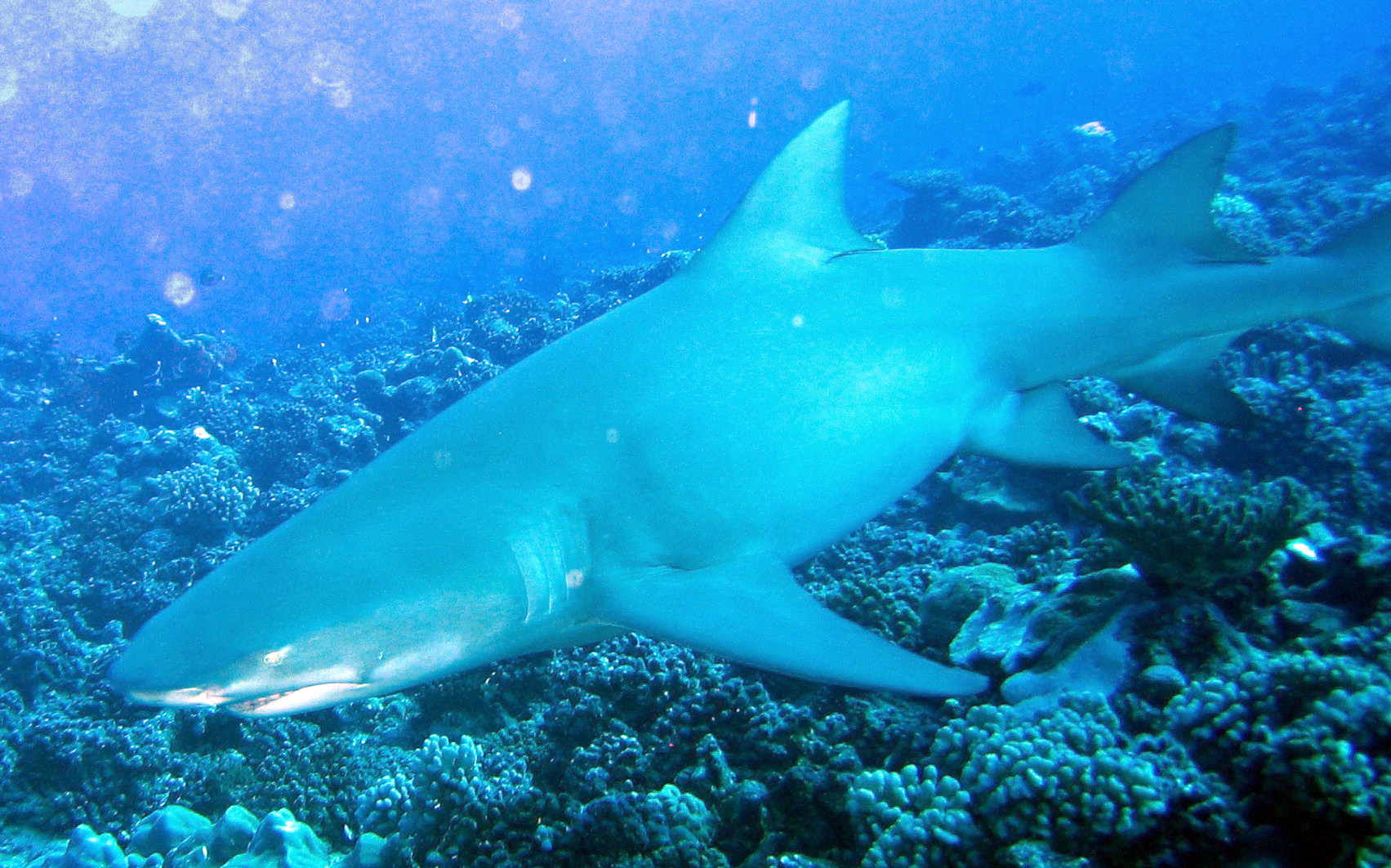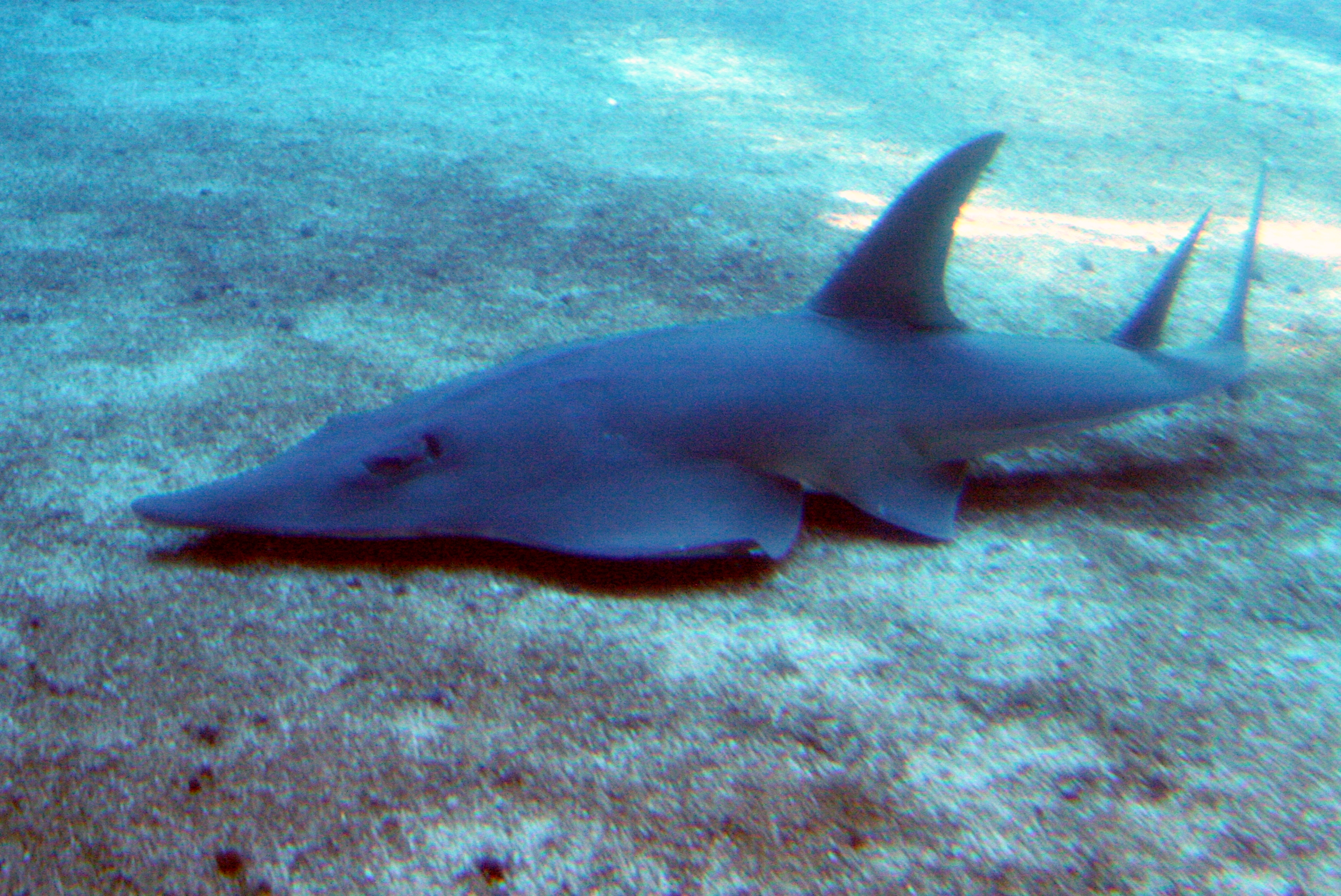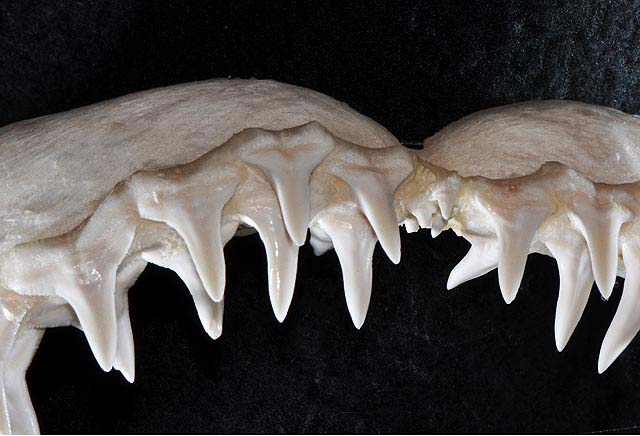|
Carcharias
''Carcharias'' is a genus of sand tiger sharks belonging to the family Odontaspididae. Once bearing many prehistoric species, all have gone extinct with the exception of the critically endangered sand tiger shark. Description ''Carcharias'' are 2.5 m long on average. The maximum weight of the shark is 158.8 kg. Differentiating species of sharks is usually done by locating and measuring their fins. The second dorsal fin and the anal fin of ''Carcharias'' are very large. In fact, they are about equal in size. The pectoral fins are triangular and only slightly larger than the dorsal fins. The teeth are very long and narrow with sharp points. The teeth are smooth with no ridges. The tail is one third of the entire body size. Diet ''Carcharias'' species hunt bony fish, small sharks, rays, squids, crabs, and lobsters. Habitat Sand tiger sharks live in water depths ranging from 0 to 190 meters. They are found in the Pacific, Atlantic, and Indian oceans. They are commonl ... [...More Info...] [...Related Items...] OR: [Wikipedia] [Google] [Baidu] |
Sand Tiger Shark
The sand tiger shark (''Carcharias taurus''), gray nurse shark, spotted ragged-tooth shark or blue-nurse sand tiger, is a species of shark that inhabits subtropical and temperate waters worldwide. It inhabits the continental shelf, from sandy shorelines (hence the name sand tiger shark) and submerged reefs to a depth of around . They dwell in the waters of Japan, Australia, South Africa, and the east coasts of North and South America. The sand tiger shark also inhabited the Mediterranean, however it was last seen there in 2003 and is presumed extinct in the region. Despite its common names, it is not closely related to either the tiger shark (''Galeocerdo cuvier'') or the nurse shark (''Ginglymostoma cirratum''). Despite its fearsome appearance and strong swimming ability, it is a relatively placid and slow-moving shark with no confirmed human fatalities. This species has a sharp, pointy head, and a bulky body. The sand tiger's length can reach but is normally 2.2–2.5 m in leng ... [...More Info...] [...Related Items...] OR: [Wikipedia] [Google] [Baidu] |
Sand Shark
Sand sharks, also known as sand tiger sharks, gray nurse sharks or ragged tooth sharks, are Lamniformes, mackerel sharks of the family (biology), family Odontaspididae. They are found worldwide in temperate and tropical waters. The three species are in two genera. Description The body tends to be brown with dark markings in the upper half. These markings disappear as they mature. Their needle-like teeth are highly adapted for impaling fish, their main prey. Their teeth are long, narrow, and very sharp with smooth edges, with one and on occasion two smaller cusplets on either side. Sand sharks have a large second dorsal fin. The sand shark can grow up to long, and most adults can weigh around . The average lifespan of both sexes is only about 7 years, though they may live longer in captivity. Location and origins The name sand shark comes from their tendency to migrate towards shoreline habitats, and they are often seen swimming around the ocean floor in the surf zone; at time ... [...More Info...] [...Related Items...] OR: [Wikipedia] [Google] [Baidu] |
Carcharhinus Amboinensis
The pigeye shark or Java shark (''Carcharhinus amboinensis'') is an uncommon species of requiem shark, in the family Carcharhinidae, found in the warm coastal waters of the eastern Atlantic and western Indo-Pacific. It prefers shallow, murky environments with soft bottoms, and tends to roam within a fairly localised area. With its bulky grey body, small eyes, and short, blunt snout, the pigeye shark looks almost identical to (and is often confused with) the better-known bull shark (''C. leucas''). The two species differ in vertebral count, the relative sizes of the dorsal fins, and other subtle traits. This shark typically reaches lengths of . The pigeye shark is an apex predator that mostly hunts low in the water column. It has a varied diet, consisting mainly of bony and cartilaginous fishes and also including crustaceans, molluscs, sea snakes, and cetaceans. This species gives birth to live young, with the developing embryos sustained to term via a placental connection to th ... [...More Info...] [...Related Items...] OR: [Wikipedia] [Google] [Baidu] |
Carcharias Falciformis
The silky shark (''Carcharhinus falciformis''), also known by numerous names such as blackspot shark, gray whaler shark, olive shark, ridgeback shark, sickle shark, sickle-shaped shark and sickle silk shark, is a species of requiem shark, in the family Carcharhinidae, named for the smooth texture of its skin. It is one of the most abundant sharks in the pelagic zone, and can be found around the world in tropical waters. Highly mobile and migratory, this shark is most often found over the edge of the continental shelf down to . The silky shark has a slender, streamlined body and typically grows to a length of . It can be distinguished from other large requiem sharks by its relatively small first dorsal fin with a curving rear margin, its tiny second dorsal fin with a long free rear tip, and its long, sickle-shaped pectoral fins. It is a deep, metallic bronze-gray above and white below. With prey often scarce in its oceanic environment, the silky shark is a swift, inquisitive, and ... [...More Info...] [...Related Items...] OR: [Wikipedia] [Google] [Baidu] |
Carcharhinus Hemiodon
The Pondicherry shark (''Carcharhinus hemiodon'') is an extremely rare species of requiem shark, in the family Carcharhinidae. A small and stocky gray shark, it grows not much longer than and has a fairly long, pointed snout. This species can be identified by the shape of its upper teeth, which are strongly serrated near the base and smooth-edged near the tip, and by its first dorsal fin, which is large with a long free rear tip. Furthermore, this shark has prominent black tips on its pectoral fins, second dorsal fin, and caudal fin lower lobe. The Pondicherry shark is critically endangered. It was once found throughout Indo-Pacific coastal waters from the Gulf of Oman to New Guinea, and is known to enter fresh water. Fewer than 20 specimens are available for study, and most aspects of its natural history are unknown. It probably feeds on bony fishes, cephalopods, and crustaceans, and gives birth to live young with the embryos forming a placental connection to their mother. Whil ... [...More Info...] [...Related Items...] OR: [Wikipedia] [Google] [Baidu] |
Carcharias Hemiodon
The Pondicherry shark (''Carcharhinus hemiodon'') is an extremely rare species of requiem shark, in the family Carcharhinidae. A small and stocky gray shark, it grows not much longer than and has a fairly long, pointed snout. This species can be identified by the shape of its upper teeth, which are strongly serrated near the base and smooth-edged near the tip, and by its first dorsal fin, which is large with a long free rear tip. Furthermore, this shark has prominent black tips on its pectoral fins, second dorsal fin, and caudal fin lower lobe. The Pondicherry shark is critically endangered. It was once found throughout Indo-Pacific coastal waters from the Gulf of Oman to New Guinea, and is known to enter fresh water. Fewer than 20 specimens are available for study, and most aspects of its natural history are unknown. It probably feeds on bony fishes, cephalopods, and crustaceans, and gives birth to live young with the embryos forming a placental connection to their mother. Whil ... [...More Info...] [...Related Items...] OR: [Wikipedia] [Google] [Baidu] |
Carcharias Acutidens
The sicklefin lemon shark (''Negaprion acutidens'') or sharptooth lemon shark is a species of requiem shark belonging to the family Carcharhinidae, widely distributed in the tropical waters of the Indo-Pacific. It is closely related to the better-known lemon shark (''N. brevirostris'') of the Americas; the two species are almost identical in appearance, both being stout-bodied sharks with broad heads, two dorsal fins of nearly equal size, and a plain yellow-tinged coloration. As its common name suggests, the sicklefin lemon shark differs from its American counterpart in having more falcate (sickle-shaped) fins. This large species grows up to long. It generally inhabits water less than deep in a variety of habitats, from mangrove estuaries to coral reefs. A slow-moving predator feeding mainly on bony fishes, the sicklefin lemon shark seldom travels long distances and many individuals can be found year-round at certain locations. Like other members of its family, this species is v ... [...More Info...] [...Related Items...] OR: [Wikipedia] [Google] [Baidu] |
Negaprion Acutidens
The sicklefin lemon shark (''Negaprion acutidens'') or sharptooth lemon shark is a species of requiem shark belonging to the family Carcharhinidae, widely distributed in the tropical waters of the Indo-Pacific. It is closely related to the better-known lemon shark (''N. brevirostris'') of the Americas; the two species are almost identical in appearance, both being stout-bodied sharks with broad heads, two dorsal fins of nearly equal size, and a plain yellow-tinged coloration. As its common name suggests, the sicklefin lemon shark differs from its American counterpart in having more falcate (sickle-shaped) fins. This large species grows up to long. It generally inhabits water less than deep in a variety of habitats, from mangrove estuaries to coral reefs. A slow-moving predator feeding mainly on bony fishes, the sicklefin lemon shark seldom travels long distances and many individuals can be found year-round at certain locations. Like other members of its family, this species is v ... [...More Info...] [...Related Items...] OR: [Wikipedia] [Google] [Baidu] |
Carcharhinus Falciformis
The silky shark (''Carcharhinus falciformis''), also known by numerous names such as blackspot shark, gray whaler shark, olive shark, ridgeback shark, sickle shark, sickle-shaped shark and sickle silk shark, is a species of requiem shark, in the family (biology), family Requiem shark, Carcharhinidae, named for the smooth texture of its skin. It is one of the most abundant sharks in the pelagic zone, and can be found around the world in tropical waters. Highly mobile and fish migration, migratory, this shark is most often found over the edge of the continental shelf down to . The silky shark has a slender, streamlined body and typically grows to a length of . It can be distinguished from other large requiem sharks by its relatively small first dorsal fin with a curving rear margin, its tiny second dorsal fin with a long free rear tip, and its long, sickle-shaped pectoral fins. It is a deep, metallic bronze-gray above and white below. With prey often scarce in its oceanic environment ... [...More Info...] [...Related Items...] OR: [Wikipedia] [Google] [Baidu] |
Carcharias Brachyrhynchos
The pigeye shark or Java shark (''Carcharhinus amboinensis'') is an uncommon species of requiem shark, in the family Carcharhinidae, found in the warm coastal waters of the eastern Atlantic and western Indo-Pacific. It prefers shallow, murky environments with soft bottoms, and tends to roam within a fairly localised area. With its bulky grey body, small eyes, and short, blunt snout, the pigeye shark looks almost identical to (and is often confused with) the better-known bull shark (''C. leucas''). The two species differ in vertebral count, the relative sizes of the dorsal fins, and other subtle traits. This shark typically reaches lengths of . The pigeye shark is an apex predator that mostly hunts low in the water column. It has a varied diet, consisting mainly of bony and cartilaginous fishes and also including crustaceans, molluscs, sea snakes, and cetaceans. This species gives birth to live young, with the developing embryos sustained to term via a placental connection to th ... [...More Info...] [...Related Items...] OR: [Wikipedia] [Google] [Baidu] |
Negaprion Brevirostris
The lemon shark (''Negaprion brevirostris'') is a species of shark from the family Carcharhinidae and is classified as a Vulnerable species by the International Union for the Conservation of Nature. Lemon sharks can grow to in length. They are often found in shallow subtropical waters and are known to inhabit and return to specific nursery sites for breeding. Often feeding at night, these sharks use electroreceptors to find their main source of prey: fish. Lemon sharks enjoy the many benefits of group living such as enhanced communication, courtship, predatory behavior, and protection. This species of shark gives birth to live young, and the females are polyandrous and have a biennial reproductive cycle. Lemon sharks are not thought to be a large threat to humans; there have been 10 recorded bites, none of which were life-threatening. The lemon shark's life span is unknown, but the average shark is 25 to 30 years old. Taxonomy The lemon shark was first named and described in 1 ... [...More Info...] [...Related Items...] OR: [Wikipedia] [Google] [Baidu] |
Carcharias Fronto
The lemon shark (''Negaprion brevirostris'') is a species of shark from the family Carcharhinidae and is classified as a Vulnerable species by the International Union for the Conservation of Nature. Lemon sharks can grow to in length. They are often found in shallow subtropical waters and are known to inhabit and return to specific nursery sites for breeding. Often feeding at night, these sharks use electroreceptors to find their main source of prey: fish. Lemon sharks enjoy the many benefits of group living such as enhanced communication, courtship, predatory behavior, and protection. This species of shark gives birth to live young, and the females are polyandrous and have a biennial reproductive cycle. Lemon sharks are not thought to be a large threat to humans; there have been 10 recorded bites, none of which were life-threatening. The lemon shark's life span is unknown, but the average shark is 25 to 30 years old. Taxonomy The lemon shark was first named and described in 1 ... [...More Info...] [...Related Items...] OR: [Wikipedia] [Google] [Baidu] |











